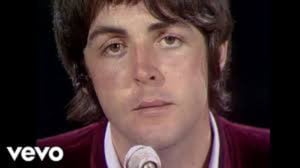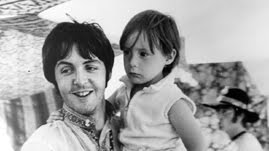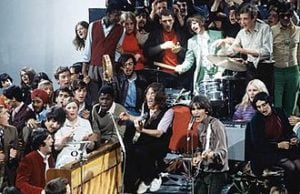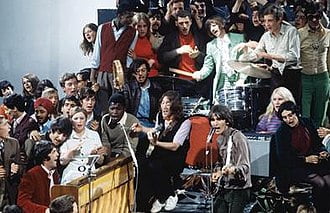
This is the second extract from my forthcoming book Who Could Ask For More: Reclaiming The Beatles. This extract features what may well be their finest hour, and explores how it focuses on the relationship between Paul and John
In 1968 The Beatles, along with the youth culture that they spoke for and symbolised, stood at a crossroads. Though the excessses of the ‘summer of .love’ had faded, the liberationist politics of what became known as the ‘new left’ were now emerging. The ‘hippie movement’ was broadening and diversifying into the ‘counter culture’, a broad social grouping and set of perspectives from which the ecological, feminist, gay liberation and ‘new age’ movements were already beginning to materialize. All of this was a reaction to the apparent insanity of the ‘straight world’ with its militaristic, oppressive culture expressed most symbolically and potently in the ultimate obscenity of the nuclear arms race. Much of this new culture took the form, at this point, of a kind of messianic idealism. It was in this spirit that The Beatles, having lost their manager and ‘guide’ Brian Epstein, now decided to handle their own affairs by setting up their own company, Apple, on which their own records and those of their protegees would be released. The Beatles themselves, along with their closest confidants like their former road managers Neil Aspinall and Mal Evans, would be ‘co-directors’ of the company. For a few euphoric months Apple – attempting to become an alternative to the ‘straight’ record companies – opened its doors to every kind of eccentric performer, and there were grandiose expansionist plans through which The Beatles (who had, sadly, no real grasp of the ‘realities’ of the business world) thought they would be able to revolutionise the media industry. Eventually, the whole edifice came crashing down like a house of cards, bringing The Beatles with it, but in mid-1968, as their first Apple single Hey Jude was released, they stood on the brink of what appeared to be a brave new world. It was appropriate, then, that the first single on their own label was to climax in a kind of universal mantra, with which the whole world could sing along. Yet ironically Hey Jude, while it expressed with great eloquence a feeling which virtually anyone could identify with, is also a song which (if perhaps unconsciously) gives voice to the tensions which were soon to tear The Beatles, and with them many of the idealistic dreams of the counterculture, apart.

In many ways Hey Jude is the supreme expression of The Beatles’ art, combining the communicative directness of their early music with the sophistication of their later years. Contained within the song is their entire history as a recording group, their key influences in the fields of soul and rock and roll, and a plethora of complex emotions. Hey Jude is, like their early defining moment She Loves You, an ‘advice song’ from one friend to another. It culminates in an expression of spiritual bliss and solidarity that is profoundly informed by the group’s journey through stardom, drugs and meditation. Like their early singles it is an ‘ecstatic’ song, building up to a great release of emotion that transcends mere words. With a sheer, aching soulfulness it articulates the emotional struggle involved in the process of artistic inspiration itself, while conveying the terrible strain of ‘carrying the world upon their shoulders’ that The Beatles had heroically taken on. Highly significant to its position as a song which ‘sums up’ everything The Beatles represented is the way it stands as both a celebration of, and in some ways a farewell to, the creative relationship which sustained the group, that between John and Paul. In later interviews John spoke rather eloquently and bitterly of his relationship with Paul as being like a ‘marriage’. He was unequivocal that his union with Yoko Ono was responsible for cutting his dependence on this relationship. Hey Jude, whether consciously or not, dramatises the ‘divorce’ between John and Paul, yet it does so without bitterness or remorse. Paul recognises that John was …made to go and get her…, that only through his relationship with Yoko can John’s terrible inner scars be healed. Paul shows himself willing to sacrifice the bond which has elevated his own life to such extraordinary heights. It’s quite a sacrifice. Yet Hey Jude never wallows in misery or self-pity. Although the emotions it presents us with hover on the edge of a great heartbreak, the singer refuses to give in to despair.

The track begins with an intimate solo …Hey…before the first stabbing note on the piano. Throughout the first verse the piano merely plays this rhythmic accompaniment while Paul’s voice carries the melody. The first lines sum up the message of the song, with the simple internal rhymes bad/sad, heart/start counterposing the repetition of better instead of a rhyme at the end of lines two and four. The second line …take a sad song and make it better…could be said to summarise the entire song. The idea of creating uplifting ‘music’ is the song’s central metaphor, underlined by the later statement that ‘Jude’ is …waiting for someone to perform with… The song itself continually builds around this simple beginning, its strikingly impressive and portentious melody being woven over more and more instruments and voices. Acoustic guitars, strummed by John and George, come in, then sighing vocal …aahs…as Paul sings …the minute you let her under your skin/then you begin to make it better…Yet again the word ‘better’ is repeated, as if it is a kind of key to the song, a magical invocation to lift the spirits. Then the drums kick in, restrained at first, as the melody builds and the emotions being expressed begin to go beyond simple advice. The lines …any time you feel the pain/Hey Jude/refrain…with their understated staccato pauses, create the impression that the singer is beginning to ‘feel the pain’ himself. The use of the musical term ‘refrain’ has a neat double meaning as the words ‘Hey Jude’ are the actual refrain of the song. The singer pleads with Jude not to …carry the world upon your shoulders… urging him not to …play it cool… and suppress his emotions towards the object of his love. At the end of this verse there is a small pause and the first few …na na na nas… Already the ‘melody of restraint’ that characterises the verses is set against the ecstatic melody that will supersede it.
In the next verse, another countermelody is set up The singer pleads with Jude not to ‘let him down’, pleading with him to follow the object of his heart’s desire. As he finishes the line …you have found her/now go and get her… the line …let it out and let it in…is slightly superimposed over his words, before it re-emerges in its ‘official’ place before …Hey Jude, begin…at the start of the next verse. It is as if a whole group of melodies are struggling to get out. The line itself mimics the most crucial element of meditative practice, the control of the breath, which is itself the key to expressive singing. Now John and George begin to join in on the lines of the verses, their voices very slightly out of synch with Paul’s, providing another ‘layer of melody’. In the next verse their vocal …aahs… return. As Paul sings the staccato lines …Don’t you know that it’s just you/Hey Jude/you’ll do… it’s as if something is catching in his throat, but he is determined to deliver the most distinctive line …the movement you need is on your shoulder… The final verse repeats the first one, but now with John and George joining in. Then, on the next …better…the song suddenly ascends into the stratosphere. Paul repeats the word four times. Each time the vocal inflexion is higher and more strangulated, as the …na na na na…melody comes in and takes over. It is as if the singer, having tried reasoned persuasion, has now gone beyond logic and can give vent to pure emotion. As the …na na na nas…build up, over the basic bass, drums and tambourine rhythm, an orchestral backing, with violins, violas, cellos, flutes, clarinets and trumpets, adds to the mix while Paul, his emotions fully unleashed, begins to ‘scat’ over the swaying mantra in the background. As the ever growing chorus wills Jude on to his destiny, Paul cries and squeals …Yeah, Yeah…you know you can make it… repeating lines from the song. Over the last minute the chorus begins slowly to fade, with the singers, the rhythm section, the orchestra and Paul’s frenetic contribution all competing against each other like layer upon layer of melody. Once the song is over it as if these melodies are hanging in the air, still being sung somewhere, as if the singers have merely moved away into the distance out of earshot. Ultimately Hey Jude is a song about the power of music itself, as a means of expression of pure passion and pure will.

A version of this text appears in WHO COULD ASK FOR MORE: RECLAIMING THE BEATLES
BEATLES SITES



Leave a Reply